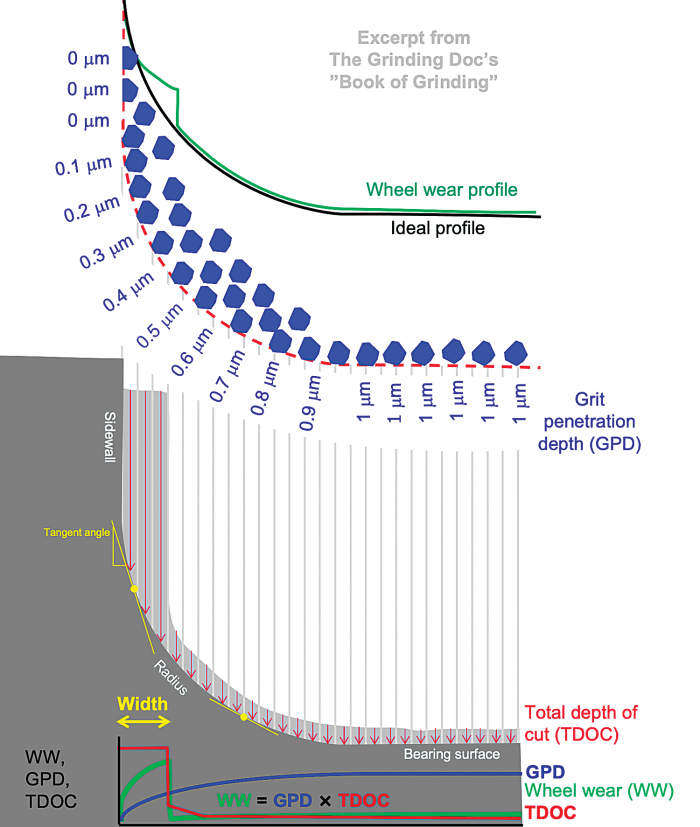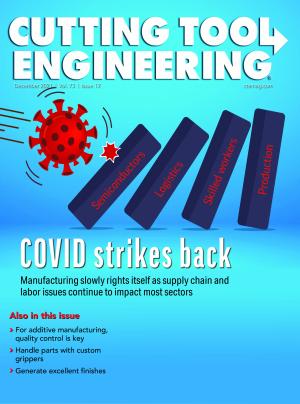Dear Doc: We cylindrical-grind crankshafts with an Al2O3 wheel in a single, straight plunge. We struggle with wheel wear on the radius and burning on the shoulder. What are we doing wrong?
The Doc replies: You’re probably not doing anything wrong. Because of its unique geometry, crankshaft grinding is pain and suffering. There are no “solutions,” just coping strategies. Here’s what is going on and how you can cope better.
First, take a few minutes to get your head around the figure. Let’s start with the bearing surface. This is straight-up cylindrical-plunge grinding and typically doesn’t cause any major issues. As we start moving up the radius, things are still OK. It’s as we begin to approach the sidewall, however, that things start to become ugly — for two reasons.

Image courtesy of J. Badger
The first reason is that because of the angle of attack on the radius, the grit penetration depth begins to be very small, meaning that the grits rub a lot. And as we move onto the shoulder, the grit penetration depth is actually zero. This means that the grits don’t do any cutting, just rubbing — and they become really dull. To make matters worse, we can’t dress away these dull grits as we can’t dress the sidewall. So they rub and become dull over multiple workpieces.
The second reason is there’s a huge amount of material near the sidewall that must be removed by a narrow portion of the wheel, which is labeled as “Width” in the figure. This isn’t a problem very close to the sidewall as the tangent angle on the wheel is small, meaning that the grit penetration depth is small. But at the end of this width, we still have a lot of material to remove — with a larger tangent angle. Since we can approximate wheel wear as wheel wear = grit penetration depth × total depth of cut, we get huge wheel wear at the end of the width. This can be seen in the wheel wear profile.
Now, how do we cope better?
First, direct a single, dedicated, high-pressure nozzle at the sidewall and width region. This will cool the rubbing region and slow down grit dulling, as well as cool and lubricate the width region, reducing wheel wear.
Second, dress the wheel slower on the radius width region where wheel wear is high. We want to “close down” the wheel to reduce wheel wear. Then dress very fast on the sidewall region when you dress after mounting the wheel. This will open up the wheel, reducing heat generation.
Third, see if you can use a “sandwich wheel” with a tougher grit and harder grade on that radius width region where wheel wear is high.
Finally, determine whether you can reduce the width region where you have all that material to remove on the sidewall. Even a modest reduction in the amount of stock to remove — not on the bearing surface but off the sidewall, axially — will reduce wheel wear. That is because the tangent angle becomes smaller as we approach the sidewall, which reduces grit penetration depth.
It’s not pretty, but these are some things that have been proven to work.
Related Glossary Terms
- burning
burning
Rotary tool that removes hard or soft materials similar to a rotary file. A bur’s teeth, or flutes, have a negative rake.
- depth of cut
depth of cut
Distance between the bottom of the cut and the uncut surface of the workpiece, measured in a direction at right angles to the machined surface of the workpiece.
- grinding
grinding
Machining operation in which material is removed from the workpiece by a powered abrasive wheel, stone, belt, paste, sheet, compound, slurry, etc. Takes various forms: surface grinding (creates flat and/or squared surfaces); cylindrical grinding (for external cylindrical and tapered shapes, fillets, undercuts, etc.); centerless grinding; chamfering; thread and form grinding; tool and cutter grinding; offhand grinding; lapping and polishing (grinding with extremely fine grits to create ultrasmooth surfaces); honing; and disc grinding.


